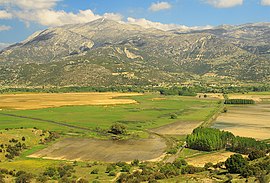Stymfalia
|
Stymfalia Στυμφαλία |
|
|---|---|
 |
|
| Coordinates: 37°53′N 22°28′E / 37.883°N 22.467°ECoordinates: 37°53′N 22°28′E / 37.883°N 22.467°E | |
| Country | Greece |
| Administrative region | Peloponnese |
| Regional unit | Corinthia |
| Municipality | Sikyona |
| • Municipal unit | 205.1 km2 (79.2 sq mi) |
| Population (2011) | |
| • Municipal unit | 2,427 |
| • Municipal unit density | 12/km2 (31/sq mi) |
| Community | |
| • Population | 184 (2011) |
| Time zone | EET (UTC+2) |
| • Summer (DST) | EEST (UTC+3) |
| Vehicle registration | ΚΡ |
Stymfalia (Greek: Στυμφαλία; Ancient Greek: Στύμφαλος Stymphalos) is a village and a former municipality in Corinthia, Peloponnese, Greece. Since the 2011 local government reform, it has formed part of the municipality of Sikyona, of which it is a municipal unit. The municipal unit has an area of 205.07 km2, while its population as of 2011 was 2,427). The seat of the municipality was in Kalianoi, 41 km southwest of the town of Kiato. The municipal unit occupies a mountain valley with an average altitude of 600 metres. Mount Kyllene dominates it to the north east, rising to a height of c. 2400 metres. The largest village is Kaisari, but the principal antiquities are just south of the modern village of Stymfalia, a hamlet of c. 150 inhabitants.
In ancient Greece, Stymphalos, lying in this valley of northwestern Arcadia, was famous as the site of one of the Labors of Hercules, the slaying of the Stymphalian birds. Hera, whose presence is never far from Heracles, was venerated at the site in an archaic form in which she took three phases, as maiden, matron, and even widow.Pindar mentions an Olympic victor in the mule-cart race (a man called Hagesias) in his sixth Olympian Ode, and urges the members of the choir to venerate their virginal Hera, who was apparently a survival of pre-Olympian religion. Pausanias mentions a statue of Dromeus, a long-distance runner from Stymphalos who won at all the Panhellenic Games in the mid-5th century BC. Little else is known of Stymphalos from ancient literature. Artemis was the principal divinity of the town and her temple seems still to have been in use in Roman times. One unusual aspect of the goddess is that her sanctuary is referred to in an inscription of the early 2nd century BC as that of Brauronian Artemis, an Athenian cult. An inscription commemorating Stymphalian hospitality to the people of Elateia was to be set up in the agora of Elateia and in the sanctuary of Brauronian Artemis at Stymphalos. Demeter and Hermes are also epigraphically attested.
...
Wikipedia


